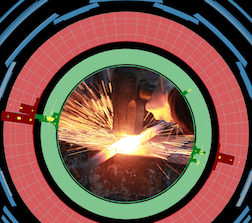Speaker
Description
Neutrino oscillations are described by the Hamiltonian, $H=\frac1{2E}M$ where $M\equiv$diag$(0,\Delta m^2_{21},\Delta m^2_{31})$ and $\Delta m^2_{ij}\equiv m^2_i-m^2_j$.
Based on solar, atmospheric, and now reactor neutrino data, we know that the mass basis is very different from the flavor basis.
The two can be related by the unitary PMNS matrix, $U$, which is a function of three mixing angles conventionally known as $(\theta_{12},\theta_{13},\theta_{23})$ and one $CP$ violating phase $\delta$.
In matter, neutrinos experience an additional contribution to the Hamiltonian that acts on the electron eigenstate differently from the other two.
Combining this gives the full Hamiltonian in matter, $H=\frac1{2E}(UMU^\dagger+A)$ where $A=$diag$(a,0,0)$ and $a\equiv2\sqrt2G_FN_eE$ is the matter potential.
While it is possible to write down the eigenvalues, angles, and transition probabilities in matter exactly, the solutions are extremely complicated and offer no compelling insights.
Instead, we consider a perturbative approach to write analytic solutions to the full three flavor problem in a useful way, while still maintaining a high degree of accuracy.
To do this, we start with an expansion parameter $\epsilon\approx\Delta m^2_{21}/\Delta m^2_{31}\approx3\%$ that is replaced by an even smaller expansion parameter that is zero in vacuum and at most $\approx1.5\%$.
To address the two level crossings in the eigenvalues, we perform two rotations to a new basis.
These rotations are described by angles that correspond to $\theta_{12}$ and $\theta_{13}$ in matter.
$\theta_{23}$ and $\delta$ remain unchanged.
In this new basis, we show that the eigenvalues and the oscillation probabilities to first order are extremely accurate.
Moreover, they are also exact for $a=0$, the vacuum case.
Evaluating the eigenvalues and probabilities in various limits, $\{a,\sin\theta_{13},\Delta m^2_{21}\}\to0$ or $|a|\to\infty$ with the exact solution to the Hamiltonian is highly nontrivial, while it is straightforward to take limits of our perturbative expansion, and the limits are exact.
We also elect to maintain the simplest $L/E$ structure in the transition probabilities by using the minimal number of $L/E$ functions allowed.
Finally, while the expressions to second order are no longer compact, we numerically show how their precision far surpasses that obtainable by even the most optimistic of future experiments.
